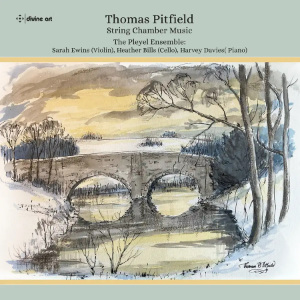
Thomas Pitfield (1903-1999)
Piano Trio No 1 in C major (1930)
Piano Trio No 2 in F minor (Lyric) (1948/1949)
Epigraph for violin, cello and piano (undated)
Sonatina for cello and piano (1945)
Sonata in D minor for cello and piano (1937/1938, publ. 1949)
The Pleyel Ensemble
rec. 2023, Carole Nash Recital Room, Royal Northern College of Music, Manchester, UK
First recordings
Divine Art DDX21137 [61]
The Divine Art label has been doing very well by British composer Thomas Pitfield in the last year or so. In addition to this disc, Divine Art recently issued a twofer Thomas Pitfield – His Friends and Contemporaries (review), and earlier in 2024 a recording of his songs (DDX21119). With recordings on other labels, Pitfield is getting the exposure he deserves. He was more than a musician. He was a polymath: poet, memoirist, artist, calligrapher, engraver, woodworker.
The shortest piece here, the Epigraph for violin, cello and piano, perfectly sums up Pitfield’s musical style: jagged rhythms, a melodic line derived from Delius and Vaughan Williams, a distinct sense of harmony, and a distinct sense of humor. All these elements are already evident in the early Piano Trio No.1, which he wrote for his future wife Alice Astbury. The piece is rather more impressionistic than his later music, but his rhythmic complexity is already there, not to mention the grasp of structure: the last movement, quite complex, is a real workout for the performers.
John Turner, the esteemed recorded player and friend of Pitfield, points out in his notes that the cello was Thomas Pitfield’s own instrument. We have here two large-scale works for the instrument. The Cello Sonata is a fully mature work, written not only with knowledge but with love for the instrument. The opening Variations movement is somberly impressive. The central Pastoral Interlude may remind some listeners of Moeran’s Cello Sonata, although Pitfield’s work predates that by several years. The Epilogue gives prominence to the piano. It develops the work’s material with the composer’s unique brand of humor.
About ten years later Pitfield wrote his short Sonatina. While brief, it is an even more substantial work than the Sonata. Pitfield’s command of his material is prominent here, as he combines the increasingly lyrical element in his work with seriousness and humor in the Preludio. He adds interesting harmonic twists in the Arietta and the Scherzino, before finishing with a typically rhythmic Toccatina.
The last piece here is the Piano Trio No. 2 “Lyric”. As mentioned above, lyricism was an increasingly important element in Pitfield’s mature music. This powerful work offers each of the performers a chance to shine. In the opening Allegro marcato, pianist Harvey Davies brings out the composer’s adroit part-writing. Cellist Heather Bills has perhaps the most challenging role with the Larghetto movement. She keeps the mood constant through rapid-fire tempo changes. In the last movement, we again have a tempo of Allegro marcato, but this movement is much more dramatic than the first. Violinist Sarah Ewins rises to the occasion with very forceful playing.
The Pleyel Ensemble comprises eleven players, but only three perform here. It was co-founded in the Manchester area in 2011 by the married couple, Heather Bills and Harvey Davies. They bring great understanding and warmth to Pitfield’s music. Sarah Ewins’s playing is so dynamic that I almost wished there were more trios here. Pitfield would surely have been very pleased with this disc. It will add to the continuing rediscovery of his music.
William Kreindler
Previous review: John France (August 2024)
Buying this recording via a link below generates revenue for MWI, which helps the site remain free



















